Key takeaways.
How to do SEO for food blogs and improve the organic traffic in Search Engines like Google or Bing? These tips & tricks can help you to achieve your goals.
- Do keyword research
- Optimize your blog post titles
- Use descriptive URLs
- Optimize your website
- Write high-quality content
- Use internal and external links
- Use analytics
- Use structured data
Food blogging is still one of the most popular blogging categories. Also, it is one of the hardest to rank well in Search Engines.
When I started my food blog called Taste Is Yours in 2016 I knew almost nothing about SEO, search engines, backlinks, or structured data.
To me, it was essential to create a new recipe each week, make nice photos, and share it with my friends and family members on Instagram, Facebook, or Pinterest. I was not using any SEO plugin, or recipe card and knew nothing about keywords or meta titles. My traffic was growing steadily each year and I thought this is the way I should do it.
But then something unexpected happened. I discovered Search Engine Optimization or SEO for short. Hyped up about my new finding I read dozens of blog posts and watched many videos. I learned the basics and immediately tested out all the SEO tips on my food blog.
And it literally changed everything. I quadrupled my organic traffic in less than 6 months, and within 2 years I occupied the highest positions for the most relevant keywords. One of them drove thousands of visitors to my food blog during the lockdown. You might think it was luck, but actually, it was a precisely executed SEO strategy.
Lastly, my passion for SEO grew so much, that in 2020 I co-founded a digital agency that focuses mostly on SEO and SEO Copywriting.
And how did I do it? What steps did I follow and how I optimized my food blog for search engines?
In this article, I will share with you the real experience that helped me succeed.
Search Engine Optimisation for Food Bloggers.
Search Engine Optimisation (SEO) is essential in driving more traffic to a food blog. It involves creating high-quality content, searching for the best keywords, and creating a solid website structure. This helps to rank the blog higher on major search engines like Google and Bing.
Food bloggers should use effective SEO tactics to help their blogs stand out from the competition. This can be done by ensuring that content is properly keyworded, as well as creating high-quality backlinks from other relevant websites. Additionally, writing compelling page titles, meta descriptions, and page headers are all important SEO tactics that will help boost ranking in search engine results pages. Finally, optimizing photos and videos with meta tags will also help increase the visibility of a food blog when searching online. By following these steps, food bloggers can improve their SEO and take their blogs to the next level.
Keyword research.
Starting with one of the most crucial aspects that can either make or break your food blog is conducting keyword research. Many food bloggers and enthusiasts, who share their passion for food through their blogs, often make a common mistake – relying on feelings and assumptions to create their content. Even I made the same mistake during my early days. They believe that creating a recipe based on their liking, such as chocolate cookies, will automatically attract readers throughout the year.
However, this approach is no longer effective in terms of SEO. The competition is intense, and the internet is filled with content. Consequently, Google has implemented a more comprehensive method of ranking content. Simply creating content based on personal preferences and posting it whenever one wants is no longer sufficient. A structured approach is necessary, and it all starts with keyword research.
What are keywords and why are they important?
What are keywords?
Keywords are words or phrases that people use to search for information on search engines like Google. They are important for Google because they help the search engine understand what a webpage or content is about, and whether it is relevant to a user’s search query.
When someone types a word (search query) into a search bar, Google’s algorithm scans the internet for content that contains the same or similar keywords. Pages that have a higher density of relevant keywords, along with other factors like backlinks and user engagement, are more likely to rank higher in Google’s search results.
For example, if someone types in “best coffee shops in New York City,” Google will look for pages that contain those exact words or related terms like “coffee shops,” “best coffee,” “New York City,” etc. Pages that have those keywords in their content, titles, descriptions, and other metadata are more likely to appear at the top of the search results.
Therefore, including relevant and specific keywords in your content can increase your chances of being found by users searching for that information, which can lead to more traffic, engagement, and conversions. However, it’s important to use keywords in a natural and relevant way, rather than just stuffing them in your content, as Google’s algorithms can detect and penalize keyword stuffing.
How to do keyword research? Easy way.
Now let’s break it down and see the process step-by-step.
Define Your Niche and Audience
Your niche is “food,” but you might want to narrow it down to a specific type of cuisine or dietary preference, such as “vegan,” “paleo,” “gluten-free,” or “low-carb.” Your audience could be people who are interested in healthy eating, cooking, baking or dining out.
Brainstorm a List of Seed Keywords
Some seed keywords for a food blog might be “recipes,” “cooking tips,” “restaurant reviews,” “food photography,” or “foodie travel.”
Use Keyword Research Tools
Use keyword research tools like Google Keyword Planner (FREE) or SE Ranking (paid) to generate more keyword ideas and find the search volume, competition, and other metrics for each keyword. Here are some examples of food-related keywords with their average monthly search volume. To show you more precisely how to do Keyword research the easy way I have decided to use the FREE Keyword Planner from Google. You can sign up for it as well, via your Google account.
Once logged in I have chosen the “Discover New Keywords” option and used the following settings: language = English and location = global.
My main search included the following keywords with the monthly search volume.
- “healthy recipes” (165,000)
- “easy dinner ideas” (368,000)
- “vegan desserts” (110,000)
- “low-carb snacks” (74,000)
Expand Your List
The main keyword research wouldn’t be enough so we have to break it further to find related keywords and long-tail keywords that are specific to your niche.
For example, let’s choose “healthy recipes” and search for low-hanging fruit keywords.
In the chart, you will see a few key metrics, like YoY (year-on-year) change, competition level, three-month change, and av. monthly search volume etc. Here I would definitely focus on long-tail keywords that have low competition and are growing in popularity.
Next, I filtered the keywords based on their YoY change to see which ones are growing in popularity.
And there it is, a keyword with growing popularity, a nice search volume (5400), and low competition that grabbed my attention is – “overnight oats recipe for weight loss”.
As a net step, I would make a recipe as soon as I could, and index it quickly in Google Search Console or via Instant Indexing.
Other interesting ideas from this search are:
- healthy brunch
- healthy appetizer recipes
- high protein crock pot recipes
- high protein breakfast meal prep
- 8 healthy breakfast ideas for weight loss
and so on…
Please be aware, that this is just a small example of how to do keyword research quickly and for FREE. The paid tools offer a much more detailed search, can recommend related keywords, and questions, and even cluster your keywords into a map. This is called keyword mapping.
Analyze the Competition
One of the most important steps is to analyze your competitors and find the keywords they are ranking for. For example, if you’re running a vegan food blog, you might want to analyze the websites of other popular vegan bloggers and see what keywords they’re using in their content. You can usually add your competitors directly in the dashboard in most of SEO tools. Also, if you are not sure who your competitors are, don’t worry, some of the tools can suggest competitors automatically.
Choose Your Target Keywords
Choose the keywords that have a high search volume, low competition, and high relevance to your niche and audience. Prioritize the keywords that have a higher chance of attracting your target audience and keeping them engaged. For example, you might want to focus on “healthy vegan recipes” or “low-carb meal prep” if that’s what your audience is looking for.
Optimize Your Content
Once you have your final keywords, you can adjust your blog posts, recipe pages, and other content around those keywords.
Use the keywords in your titles, meta descriptions, ALT tags, headers, and content, but avoid keyword stuffing and focus on natural language and readability. Keyword stuffing is basically putting your main keyword everywhere. WordPress plugins like Yoast SEO or Rank Math PRO can help you with keeping it under control.
For example, you can write a blog post titled “10 Healthy Vegan Recipes for a Quick and Easy Dinner,” and use the keyword “healthy vegan recipes” in your title, URL, and throughout your post.
Optimize your blog post titles.
Optimizing your blog post titles is important for both search engines and readers.
In the second year of my food blog, I did a test that was about titles. I picked 20 recipes that were bringing almost zero traffic and changed their titles to be more creative. Basically, I stuffed them with keywords. After 3 months of waiting, I found out that the title project didn’t work as expected.
When I looked closely at the issue I realized that the titles were not only stuffed with irrelevant words but also lacked any humanity.
They were simply not interesting enough to get any clicks from users. And my click-through rate stumbled.
What helped me to get back on track were two things. A headline analyzer from Hubspot and later the Headline Analyser is directly included in the Rank Math SEO plugin. If you don’t have it installed on your food blog you can always use the Free Headline Analyzer Tool. Once I started to adjust the titles I have seen almost immediate progress. And what did I do exactly?
Here are some of my favorite tips that can help you write better titles:
Use relevant Keywords
Incorporate relevant keywords into your blog post titles, such as the main ingredient, type of cuisine, cooking method, or dietary preference. For example, “5 Delicious Vegan Dessert Recipes” or “How to Make Homemade Pasta from Scratch.”
Keep it Short and Sweet
Keep your blog post titles short and to the point, ideally between 50-60 characters. This will make it easier for readers to understand what your post is about and for search engines to index your content. For example, “Quick and Easy Dinner Recipes Under 30 Minutes” or “The Ultimate Guide to Gluten-Free Baking.”
Be Descriptive and Specific
Use descriptive and specific words that accurately reflect the content of your post. This will help readers to understand what they can expect from your post and increase the chances of them clicking on it. For example, “Healthy Meal Prep Ideas for Busy Weekdays.”
Use Numbers and Power Words
Use numbers and powerful words to make your blog post titles more compelling and engaging. For example, “10 Budget-Friendly Meal Ideas That Taste Expensive” or “The Secret to Perfectly Crispy Fried Chicken Every Time.”
Avoid Clickbait and Misleading Titles
Avoid using clickbait or misleading titles that promise more than what your post delivers. This can lead to high bounce rates and a negative impact on your credibility. For example, “You Won’t Believe How Easy This Recipe Is!” or “The Best Chocolate Cake in the World (According to Me).”
Remember, your blog post title is the first thing that readers see, so make sure it accurately reflects the content of your post and entices them to click through and read more.
Use descriptive URLs.
As I mentioned earlier my first two years of food blogging were not so rosy. I tried to do what felt right and not what was right. This included my URL project, which failed enormously.
I simply had a feeling that the best would be to increase the length of my URLs and include more information. Meaning, stuff them with more keywords. Similarly to the title test I did earlier, this solution did not work out as well.
The reason? I overlooked one very important piece of information. When Google actually crawls each website, they use the URL as one of the signals to understand what the page is about. If your URL is descriptive and contains relevant keywords, it can help search engines understand the topic of your page and rank it higher for relevant searches.
On the other hand, if you use generic or non-descriptive URLs, it can harm your SEO efforts.
Just to give you an example here is one of the URLs I used on my food blog: https://www.mysite.com/Quick-traditional-Hungarian-letcho-to fill-you-up-in-hot-summer-weeks-that-saves-you-time-and-money-(lecso)/
Just the part after the website name is 108 characters long. Btw, the limit for permalinks is 75 characters. The second issue could be the usage of brackets at the end of the link.
And now take a look at the new URL I created later on: https://www.mysite.com/quick-traditional-hungarian-letcho/
Do you see the difference? Hopefully yes 🙂
Other examples could be this:
Good URL: https://www.myfoodblog.com/recipe/paleo-chicken-stir-fry
Bad URL: https://www.myfoodblog.com/12345
In the first example, the URL is descriptive and includes relevant keywords that indicate what the page is about (a Paleo chicken stir-fry recipe). The URL is also easy to read and understand, both for humans and search engines.
In the second example, the URL is generic and doesn’t provide any indication of what the page is about. It also includes a random number sequence, which can make it difficult for users and crawlers to understand the content of the page.
To make your URLs stand out in search engines, here are a few tips:
Use descriptive keywords
Include relevant keywords in your URLs that accurately describe the content of your page. This can help your page rank higher for relevant searches.
Keep it short
Try to keep your URLs concise and to the point. Long URLs can be difficult to read and may be truncated in search results.
Use hyphens “‐”
Use hyphens to separate words in your URLs. Avoid using underscores or spaces, as they can cause issues with search engines.
Avoid using stop words
Avoid using words like “and”, “the”, or “of” in your URLs, as they add unnecessary length and don’t provide any value.
Use a consistent format
Use a consistent format for your URLs throughout your site. This can help with organization and make it easier for Google to understand the structure of your site.
If you own a food blog that is created on WordPress you can change the permalink settings in the dashboard/settings/permalinks.
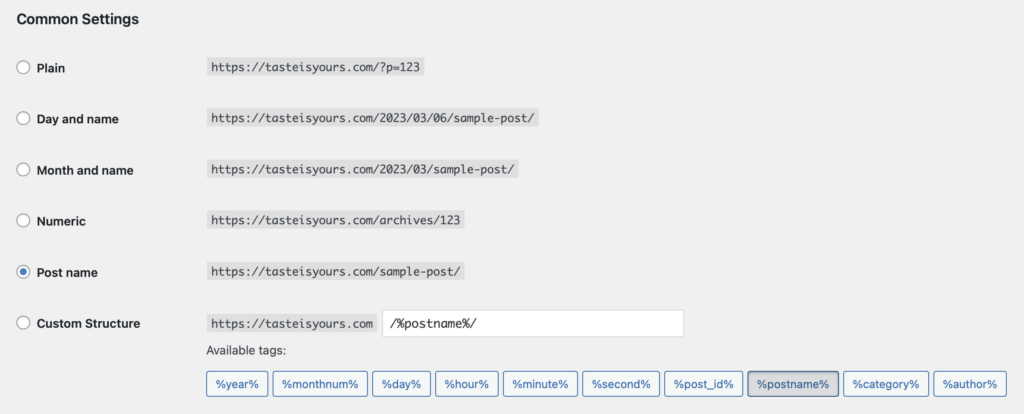
Optimize your website.
In this chapter, I will tell you step by step how to optimize your website in a simple way. Also, I will mention the best tools, that we use at Tasty Traffic or my other Digital Agency.
So let’s go.
One of the ways how to increase search traffic is to have an optimized website. And I do not mean filed with long tail keywords. What I mean is a blog that is created for the 21st century.
Many new bloggers buy their WordPress themes on Themforest or other online portals. They look for functionalities like Facebook messenger, elegant contact forms, or an option to show images or videos in sliders. What they do not take into account is that all those themes are created to look nice. And only a few of them are actually created with performance in mind.
The best themes I tested were Kalium, Astra, and Soledad. For my other website projects, I use page builders like Divi or Elementor.
Fortunately, the market demand for fast themes is growing and also, and there are many ways how to optimise sites even further with plugins.
Use a website speed test tool
Before you start doing any changes to your food blog, make sure that you analyze it properly. There are many tools for testing:
- GTMetrix
- Pigdom
- Google PageSpeed
- DotCom Tools
- SpeedCurve (for advanced users)
And if you are a Chrome user you can always use the free Lighthouse extension.
Either way, check your website first.
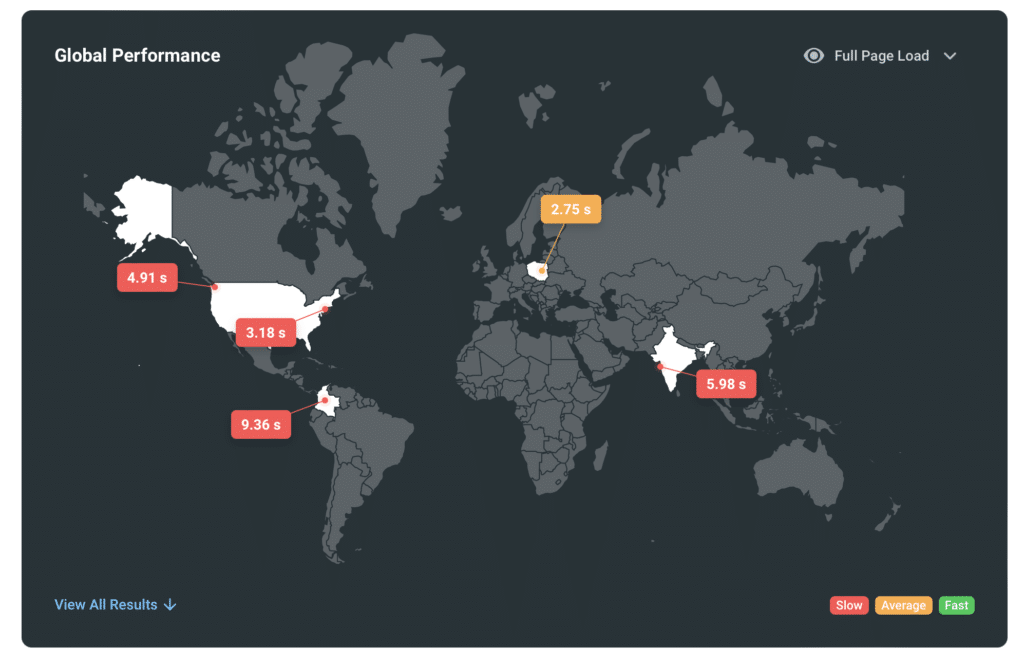
Compress images
Once you will run your page speed tests you will probably see issues like “Defer offscreen images”, “Serve images in next-gen formats” or “Properly size images”. If you are a new website owner you have probably no idea what those are. In short, all you need to know is that they are all image related and are slowing down your food blog. Don’t worry, all these issues can be fixed easily.
The best solution is to use a compression plugin like TinyPNG, EWWW Image Optimizer, Smush PRO, or Imagify. They can all help you to compress your images and serve them as WebP files.
This will reduce the file size and speed up your site in no time.
If you own a food blog with global reach we recommend using CDN (Content Delivery Network) to deliver your website and content. This way your website is served from multiple locations and downloads the content faster locally.
Use a caching plugin
Once you optimize your images it is time to take another step, to install a caching plugin. If you are not sure what caching is imagine it like this.
Caching is like keeping important files on your desk for easy access. It means storing copies of frequently used files in a temporary storage location. So instead of searching for them every time you need them, you can quickly access them from the cache.
Caching is important for website performance because it can significantly improve the loading speed of web pages. When a user visits your website, their browser sends a request to the server to retrieve the files needed to display the page.
If those files are cached, the browser can retrieve them from the cache instead of making a new request to the server. This saves time, resulting in faster loading times for the user. And faster loading times mean better user experience and increased engagement on the website. Not to mention, that it can lead to better conversion rates and ultimately, a more successful website.
If your site is hosted on WordPress, the best and easiest way is to install a caching plugin. I strongly recommend WP Rocket as it had the best results during a test I did for our digital agency’s website. Below you can see screenshots from the test.


Other caching plugins worth mentioning are:
- LiteSpeed Cache
- W3 Total cache
- WP Optimize
- Autoptimise
- Fastest Cache (FREE and one of my favorites)
- Hummingbird PRO
Optimise code
As I mentioned earlier some of the themes have significantly bigger codes and scripts. This always leads to a slow speed and even the best optimization plugin will not help here.
Therefore if you own an outdated theme, I recommend trying to optimize its code. If you are not sure how to do that, please let us know, our experienced IT gurus will be able to help.
Write high-quality content.
Creating high-quality content is probably the most challenging part in order to achieve SEO success. Today there are dozens of tools that can help you do the research, give you ideas or even write full articles. I mean tools powered by AI like ChatGPT or Writesonic.
On the other hand, it is much harder to create content that ranks on Google. One of the reasons is that users and search engines got smarter. They both quickly recognize if the content is good or not. And yes, Google can figure out that you are using an AI tool. Unless you adjust the content properly 🙂
One of the SEO best practices is to follow a guideline called Experience-Expertise-Authoritativeness-Trust or E-E-A-T short. If are interested feel free to read the full E-E-A-T guideline.
For now, I will keep it simple and try to explain it with an example of a foodie.
So imagine you are creating a new recipe. In order to make it stand out you should start by describing your Experience. Tell the readers how you felt during the preparation, cooking, or baking. Explain the pros and cons, tell them what worked well, and also give them your recommendations. This way you will be showing them your Expertise. The more you tell and show, the bigger Authoritativeness you will create. People will believe that you know what you do. And they will start to Trust you.
To give you more information about SEO Copywriting in general, we have created FREE SEO Copywriting Training. This is available to everyone who joins us and signs up for an SEO Kit.
Use internal and external links
Starting a blog is easy. Achieving success is a bit harder and slightly complicated. As you see, you have to create a fast website, do keyword research and find the right keywords, and optimize cache or codes while still cooking and making food photos.
And now let’s make it even more complicated and time-consuming. Let’s talk about links.
Google takes links as an important ranking factor and ranks websites according to their link structure. When a website receives a link from another website, it is seen as an important signal that the content (recipes in this case) on the linked website is high-quality and relevant. However, not all links are created equal. Google also evaluates the quality of the website providing the link, as well as the context of the link, to determine how much weight to give it.
In case you have the Google Search Console connected to your site, you can see your link structure under the “LINKS” tab in the menu. The report is divided into 2 main parts External (left) and Internal links (right). Within the external links, you can see the top linked pages, top linking sites, and top linking text.
How to get external links?
Now let’s talk quickly about how to get external links, that are really important for food blogs.
One of the ways to acquire high-quality links is to do guest blogging. You can always hit up a fellow blogger and agree to guest blog and backlink exchange. Another way of creating external links is to simply put your content out there. Use recipe-sharing sites like Foodgawker, TheFeedFeed or create pins with links on Pinterest. And believe me or not, if your content is good enough, people will be happy to link to it.
How to get internal links?
For a food blog, the best is to create a solid internal linking structure. Make sure that you link your recipes with each other. For example, You have a Chocolate Cookie recipe and a Top 10 Christmas Recipes round-up post. What you should do is link them both together. The more internal links you create the better. I would strongly recommend adding up to 10 internal links to each recipe. This will make it easier to understand by crawlers and easier to rank.
When you create internal links please follow this advice. Always create a descriptive anchor text. This will help readers understand what the linked source is about and provide additional context.
Here is an example of a good and bad anchor text. I used lorem ipsum text just to make it look easier.
Bad anchor text example: “Lorem ipsum dolor sit amet, consectetur adipiscing elit, CLICK THE RECIPE HERE sed do eiusmod tempor incididunt ut labore et dolore magna aliqua.
Good anchor text example: “Lorem ipsum dolor sit amet, consectetur adipiscing elit, CHOCOLATE COOKIE RECIPE sed do eiusmod tempor incididunt ut labore et dolore magna aliqua.
Also, make your internal links relevant. Don’t try to create them just for sake of it. So no Easter recipes in Christmas posts or Meat recipes in Vegan blog posts.
Use analytics
If you are really serious about your blogging you will need to use analytics. And I do not mean only to see your daily page views at Jetpack or MonsterInsights 🙂
Each website I create or take care of at Tasty Traffic has several tools connected from day one. This way I have a complete overview of what’s going on and can react very quickly to any issues.
My go-to tools include:
- Google Analytics 4 – general analytics, acquisition, and user engagement
- Google Search Console – Sitemaps, Core Web Vitals, Search Performance, Links, and site indexing
- SE Ranking – SEO audits, Competitor checks, Rankings, and Traffic overviews
- SEMRUSH – backlinks
- Ahrefs – in-depth technical SEO
- Optional: Hotjar (UX)
For you, it is most important to analyze data that can bring you closer to your end goal. Thanks to the above-mentioned tools you will know exactly, what recipes work well, how people search for them, how your titles attract users, and what issues your website has.
In both of our SEO kits we offer a regular weekly or monthly report. Based on the data we give you our observations and recommendations. So you can spend more time cooking than analyzing charts 🙂
Use structured data.
Structured data is very important for a food blog because it can provide additional information about your recipes to search engines. This can improve your website’s visibility in search results and make your recipes more attractive to potential readers.
Structured data, also known as schema markup, is nowadays a standardized format for providing information about a page and its content to search engines. When you add structured data to your recipes, you can provide information such as the name of the recipe, the ingredients, cooking time, and nutritional information. With recipes, it is also important to add ratings to showcase how good and popular a recipe is.
This information is then displayed in search results, making it easier for users to find what they are looking for and encouraging them to click through to your website.
The best is to show you an example of how the structure looks in Google.
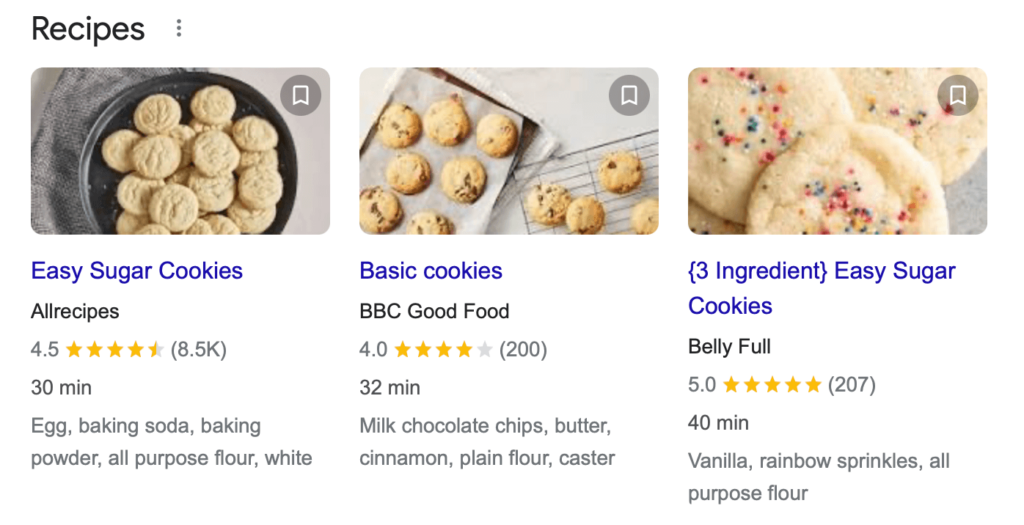
And here is an example of how structured data look on Pinterest. The pin was shared directly from the recipe card.
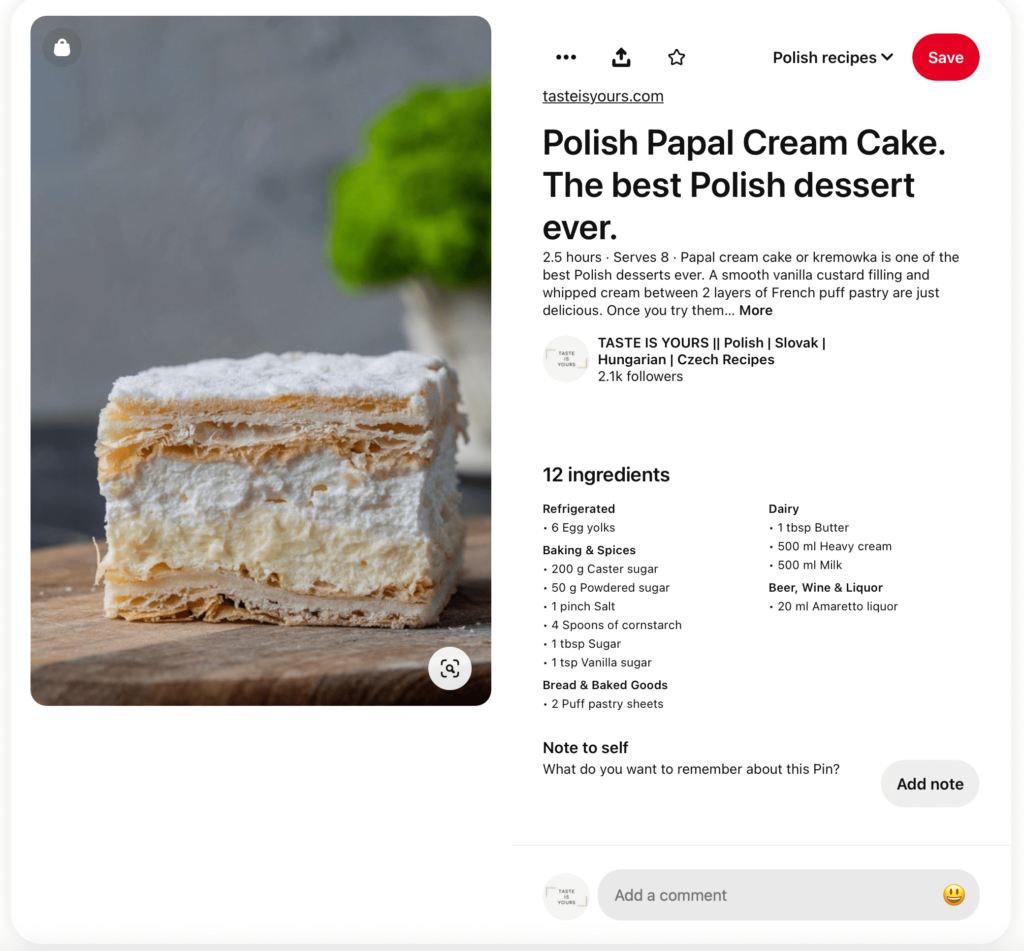
In order to add structured data to your site you can simply install SEO plugins like Rank Math PRO or Yoast SEO. Also, make sure you are using an optimized recipe card plugin like WP Recipe Maker, Tasty Recipes, Recipe Card Blocks from WPZOOM, or Create by Mediavine.



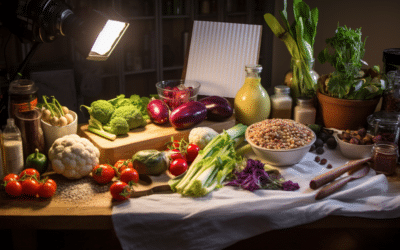

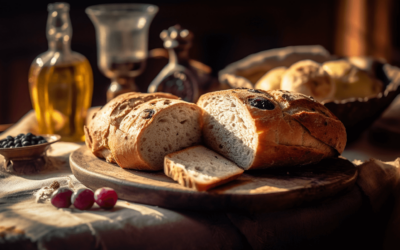
0 Comments
Trackbacks/Pingbacks